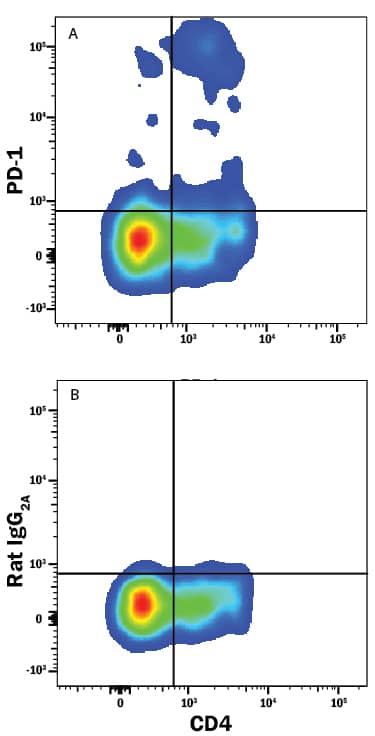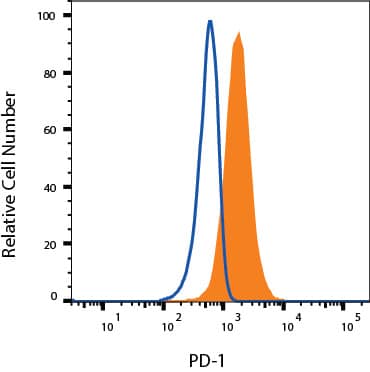Mouse PD-1 PE-conjugated Antibody
R&D Systems, part of Bio-Techne | Catalog # FAB7738P


Key Product Details
Validated by
Species Reactivity
Validated:
Cited:
Applications
Validated:
Cited:
Label
Antibody Source
Product Specifications
Immunogen
Leu25-Gln167
Accession # Q02242
Specificity
Clonality
Host
Isotype
Scientific Data Images for Mouse PD-1 PE-conjugated Antibody
Detection of PD‑1 in Mouse Splenocytes by Flow Cytometry.
Mouse splenocytes treated with 5 µg/mL PHA for 72 hours were stained with Rat Anti-Mouse PD-1 PE-conjugated Monoclonal Antibody (Catalog # FAB7738P, filled histogram) or isotype control antibody (Catalog # IC006P, open histogram). View our protocol for Staining Membrane-associated Proteins.Detection of PD-1 in Mouse Thymocytes by Flow Cytometry.
Mouse thymocytes gated on CD3+CD8+cells were stained with Rat Anti-Mouse CD4 Alexa Fluor® 405-conjugated Monoclonal Antibody (FAB554V) and either (A) Rat Anti-Mouse PD-1 PE-conjugated Monoclonal Antibody (Catalog # FAB7738P) or (B) Rat IgG2APhycoerythrin Isotype Control (IC006P). View our protocol for Staining Membrane-associated Proteins.Detection of PD-1 in EL-4 cells by Flow Cytometry
EL-4 cells were stained with Rat Anti-Mouse PD-1 PE-conjugated Monoclonal Antibody (Catalog # FAB7738P, filled histogram) or isotype control antibody (Catalog # IC006P, open histogram). View our protocol for Staining Membrane-associated Proteins.Applications for Mouse PD-1 PE-conjugated Antibody
Flow Cytometry
Sample: Mouse splenocytes treated with PHA and mouse thymocytes gated on CD3+ CD8+ cells or EL-4 cells.
Formulation, Preparation, and Storage
Purification
Formulation
Shipping
Stability & Storage
- 12 months from date of receipt, 2 to 8 °C as supplied.
Background: PD-1
Programmed Death-1 (PD-1) is a type I transmembrane protein belonging to the CD28/CTLA-4 family of immunoreceptors that mediate signals for regulating immune responses (1). Other members of this family include CD28, CTLA-4, and ICOS (2-4). PD-1 is most closely related to CTLA-4 and shares approximately 24% amino acid (aa) sequence identity. The mouse PD-1 gene encodes a 288 aa protein with a putative 20 aa signal peptide, a 149 aa extracellular region with one immunoglobulin-like V-type domain, a 21 aa transmembrane domain, and a 98 aa cytoplasmic region. The cytoplasmic tail contains two tyrosine residues that form the immunoreceptor tyrosine-based inhibitory motif (ITIM) and immunoreceptor tyrosine-based switch motif (ITSM) that are important in mediating PD-1 signaling. Mouse and human PD-1 share approximately 69% aa sequence identity. Two B7 family proteins, PD-L1 (also called B7-H1) and PD-L2, have been identified as PD-1 ligands (5, 6). PD-1 is expressed on activated T cells, B cells, myeloid cells, and on a subset of thymocytes. PD-1 deficient mice have a defect in peripheral tolerance and spontaneously develop autoimmune diseases. Binding of PD-1 to PD-L1 or PD-L2 results in the inhibition of TCR-mediated proliferation and cytokine production as well as BCR-mediated signaling. PD-1 likely has an inhibitory role in regulating immune responses (1-4).
References
- Ishida, Y. et al. (1992) EMBO J. 11:3887.
- Sharpe, A.H. and G.J. Freeman (2002) Nat. Rev. Immunol. 2:116.
- Coyle, A. and J. Gutierrez-Ramos (2001) Nat. Immunol. 2:203.
- Nishimura, H. and T. Honjo (2001) Trends Immunol. 22:265.
- Latchman Y. et al. (2001) Nat. Immun. 2:261.
- Tamura, H. et al. (2001) Blood 97:1809.
Long Name
Alternate Names
Entrez Gene IDs
Gene Symbol
UniProt
Additional PD-1 Products
Product Documents for Mouse PD-1 PE-conjugated Antibody
Product Specific Notices for Mouse PD-1 PE-conjugated Antibody
For research use only

